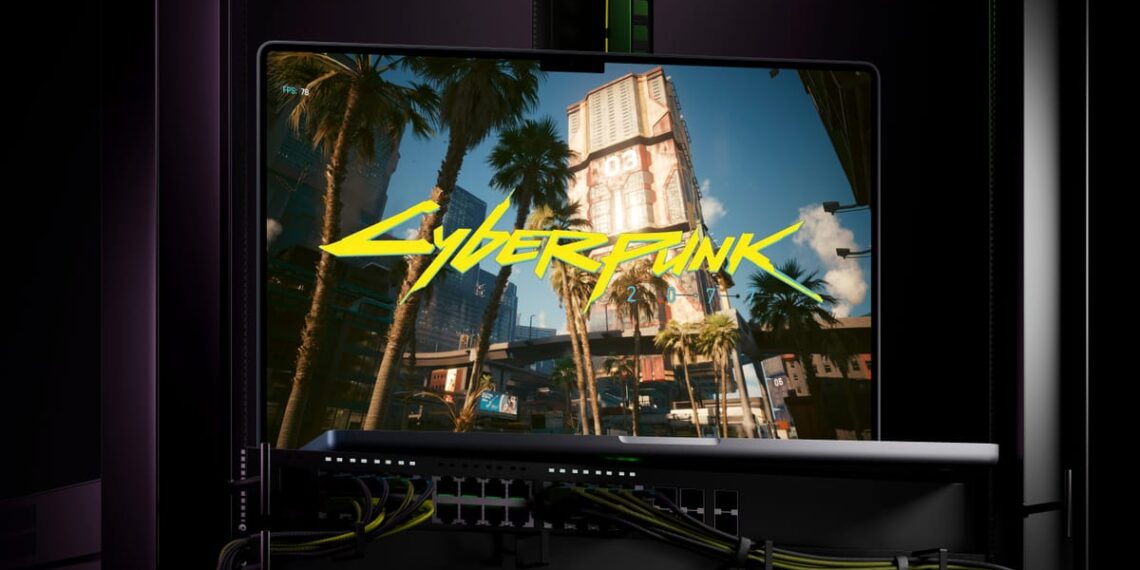When CD Projekt Red announced Cyberpunk 2077 for Mac, skepticism ran high. After all, this is the same game that brought powerful gaming PCs to their knees at launch. But after extensive testing on a base M4 Mac Mini, the results are genuinely surprising. Cyberpunk 2077 is the Crisis of modern-day video games. It is an incredibly demanding open-world experience that can make even the most decked-out PC setups sweat. Yet Apple Silicon proves it’s more capable than many expected.
Table of Contents
Cyberpunk 2077: Test Setup and Expectations
Testing was conducted on a base M4 Mac Mini with modest specs that most office workers would recognize. The setup included a 10-core CPU, 10-core GPU, 16GB unified memory, and 256GB SSD connected to a 1080p 120Hz monitor. This represents the entry-level Mac gaming experience rather than high-end configurations.

Initial expectations were low, considering Cyberpunk 2077’s reputation as a hardware destroyer. So when I heard that CD Projekt Red is bringing the game to Mac, I let out a small chuckle. “There’s no way a Mac can handle this game, even with Apple Silicon,” I said to myself.
Performance Results: Better Than Expected
Standard “For This Mac” Settings
| Setting Configuration | Average FPS | Maximum FPS | Minimum FPS |
|---|---|---|---|
| For This Mac (30 FPS target) | 32 | 33 | 24 |
| For This Mac (120 FPS target) | 33 | 37 | 30 |
| AMD FSR 3.1 Quality + Frame Gen | 65 | 77 | 56 |
| MetalFX Quality + Frame Gen | 69 | 82 | 59 |
With these settings, my M4 Mac Mini ran the game at a locked 30 FPS. This was by far the most stable option that I found, as even in intense gunfights or zooming past the busy streets, the FPS barely dropped.
The game’s automatic optimization works excellently, utilizing MetalFX Dynamic Resolution Scaling to maintain consistent performance. While 30 FPS might seem modest by gaming standards, the stability makes for a surprisingly enjoyable experience.
Upscaling Technologies: AMD FSR vs MetalFX
AMD FSR 3.1 Performance
AMD’s FSR 3.1 with Quality upscaling and frame generation delivered impressive results. With these settings, Cyberpunk 2077 could finally touch the standard 60 FPS and beyond. The frame rate averaged around 65 FPS, even reaching highs of 77.
The Dynamic Resolution Scaling variant pushed performance even higher, averaging 76 FPS with peaks of 89 FPS. However, visual quality took a slight hit compared to Quality mode.

MetalFX: Apple’s Secret Weapon
MetalFX proved surprisingly effective, often delivering better visual fidelity than FSR 3.1. MetalFX did offer a better fidelity in terms of visual upscaling, even one-upping FSR 3.1, if you ask me.
The optimal configuration combined MetalFX Quality upscaling with FSR 3.1 frame generation, achieving 69 FPS average with excellent visual quality and minimal input lag.
Ray Tracing: Possible But Compromised
Ray tracing functionality exists on the M4 Mac, though with significant trade-offs:
| Ray Tracing Configuration | Average FPS | Visual Quality | Playability |
|---|---|---|---|
| RT Medium + MetalFX | 23 | Heavily compromised | Choppy |
| RT Medium + MetalFX + Frame Gen | 41 | Soft, less detailed | Acceptable |
Ray tracing is also possible on the little M4 Mac Mini. It was set to Medium with the rest of the options enabled except for path tracing settings. However, the performance cost is substantial, making it unsuitable for extended gaming sessions on base M4 hardware.
Recommended Settings for Optimal Experience
After extensive testing, the sweet spot emerged:
- Resolution: Native 1080p
- Upscaling: MetalFX Quality
- Frame Generation: FSR 3.1 enabled
- Ray Tracing: Disabled
- Expected Performance: 60+ FPS with excellent stability
In these settings, the delay was quite minimal, and the same goes for artifacting. I managed to play through a sizeable chunk of the story with these settings and did not run into any game-breaking issues whatsoever.
Thermal Performance and System Behavior
Despite intensive gaming workloads, the M4 Mac Mini maintained impressive thermal performance. Both CPU and GPU reached approximately 70°C after extended gaming sessions while remaining completely silent. This thermal efficiency demonstrates Apple Silicon’s optimization for sustained performance.
The unified memory architecture proves its worth, with 16GB handling the game’s memory demands adequately, though more RAM would likely enable higher settings without upscaling.
Real-World Gaming Experience
Beyond raw numbers, the actual gaming experience exceeded expectations significantly. I never thought I would say this, but my experience playing Cyberpunk 2077 on a Mac was good. It was much, much better than what I expected to get out of this tiny $600 system.
The game delivers console-quality performance comparable to Xbox Series S, making it a viable option for Mac users wanting to experience Night City without purchasing dedicated gaming hardware.
Who Should Consider Mac Gaming?
This testing reveals Mac gaming’s viability for specific user groups:
Ideal Candidates:
- Mac users wanting occasional gaming without additional hardware
- Players prioritizing convenience over maximum visual fidelity
- Those seeking solid 60 FPS performance at 1080p
- Gamers comfortable with console-level visual quality
Better Alternatives Exist For:
- Enthusiasts demanding 4K ray-traced gaming
- Competitive players requiring 120+ FPS
- Users wanting maximum visual settings
The Future of Mac Gaming
CD Projekt Red has wonderfully optimized the game for Apple hardware, even the one’s with limited resources. This optimization quality suggests Mac gaming’s potential when developers invest proper effort in Apple Silicon compatibility.
The combination of MetalFX upscaling, efficient thermal design, and unified memory architecture creates a compelling gaming platform that many overlooked.
Final Verdict: Surprisingly Competent
Cyberpunk 2077 on M4 Mac represents a turning point for Apple Silicon gaming. This has changed my perception of gaming on a Mac, and it might do the same for you. While not replacing dedicated gaming rigs, it proves Macs can deliver enjoyable AAA gaming experiences.
For Mac users curious about gaming, Cyberpunk 2077 offers an excellent test case that demonstrates Apple Silicon’s genuine gaming capabilities.
FAQs
Q: What FPS can I expect when playing Cyberpunk 2077 on a base M4 Mac?
A: On a base M4 Mac Mini with 16GB RAM, you can expect around 30 FPS with default “For This Mac” settings, or 60-70 FPS using MetalFX Quality upscaling with FSR 3.1 frame generation. The optimal configuration delivers an average of 69 FPS with a maximum of 82 FPS and minimum of 59 FPS, providing a smooth and stable gaming experience at 1080p resolution.
Q: Should I enable ray tracing when playing Cyberpunk 2077 on M4 Mac?
A: Ray tracing is not recommended on base M4 Mac hardware. While possible, it reduces performance to around 23 FPS average without frame generation, or 41 FPS with frame generation enabled. The visual quality also becomes heavily compromised with soft, less detailed graphics. For the best experience, disable ray tracing and focus on achieving 60+ FPS with standard lighting, which still looks excellent thanks to the game’s overall visual design.








